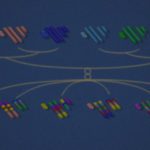Link to Pubmed [PMID] – 22110678
PLoS ONE 2011;6(11):e27582
BACKGROUND: In a previous work, using an interspecific recombinant congenic mouse model, we reported a genomic region of 23 Mb on mouse chromosome 11 implicated in testis weight decrease and moderate teratozoospermia (∼20-30%), a Quantitative Trait Locus (QTL) called Ltw1. The objective of the present study is to identify the gene underlying this phenotype.
RESULTS: In the present study, we refined the QTL position to a 5 Mb fragment encompassing only 11 genes. We showed that the low testis weight phenotype was due to kinetic alterations occurring during the first wave of the spermatogenesis where we could point out to an abnormal lengthening of spermatocyte prophase. We identify Fidgetin-like 1 (Fignl1) as the gene underlying the phenotype, since if fulfilled both the physiological and molecular characteristics required. Indeed, amongst the 11 positional candidates it is the only gene that is expressed during meiosis at the spermatocyte stage, and that presents with non-synonymous coding variations differentiating the two mouse strains at the origin of the cross.
CONCLUSIONS: This work prompted us to propose Fignl1 as a novel actor in mammal’s male meiosis dynamics which has fundamental interest. Besides, this gene is a new potential candidate for human infertilities caused by teratozoospermia and blockades of spermatogenesis. In addition this study demonstrates that interspecific models may be useful for understanding complex quantitative traits.

